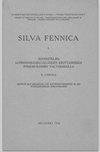基于物理的森林反射率模型的参数化改进,用于检索北方森林结构特性
IF 1.8
3区 农林科学
Q2 FORESTRY
引用次数: 1
摘要
基于物理的反射率模型为遥感评估植被生物物理特征提供了一种可靠且可转移的方法。森林在许多尺度上都表现出明确的结构,从嫩枝到景观斑块,因此对植被反射率建模者提出了具体的挑战。为了将森林反射率与其结构联系起来,必须对其复杂性进行参数化,从而增加反射率模型输入的数量。参数化将反射率模拟与可测量的森林变量联系起来,但同时依赖于抽象(例如,形成树冠的几何表面)和基于物理的简化,难以可靠地量化。随着森林基本结构(如树高和林分密度)和光学特性(如树叶和森林地面反射率)的高质量数据越来越多,我们使用经过验证的森林反射率和透射率模型FRT来研究“不确定”输入参数值对模拟森林反射率精度的影响。利用最先进的森林结构和光谱信息以及Sentinel-2多光谱仪器图像,我们发现,在基本林业变量设置为其真实值且叶片质量由可靠的异速生长模型确定的情况下,对模型反射率影响最大的输入参数是树木分布的规律性和木本元素的数量。当这些参数设置为新的调整值时,模型性能得到了显著提高,在近红外光谱区域(740 ~ 950 nm)接近零偏差,相对RMSE为13%,相关系数为0.81。在光谱可见部分,模型性能不一致,表明有改进的余地。本文章由计算机程序翻译,如有差异,请以英文原文为准。
Improved parametrisation of a physically-based forest reflectance model for retrieval of boreal forest structural properties
Physically-based reflectance models offer a robust and transferable method to assess biophysical characteristics of vegetation in remote sensing. Forests exhibit explicit structure at many scales, from shoots and branches to landscape patches, and hence present a specific challenge to vegetation reflectance modellers. To relate forest reflectance with its structure, the complexity must be parametrised leading to an increase in the number of reflectance model inputs. The parametrisations link reflectance simulations to measurable forest variables, but at the same time rely on abstractions (e.g. a geometric surface forming a tree crown) and physically-based simplifications that are difficult to quantify robustly. As high-quality data on basic forest structure (e.g. tree height and stand density) and optical properties (e.g. leaf and forest floor reflectance) are becoming increasingly available, we used the well-validated forest reflectance and transmittance model FRT to investigate the effect of the values of the “uncertain” input parameters on the accuracy of modelled forest reflectance. With the state-of-the-art structural and spectral forest information, and Sentinel-2 Multispectral Instrument imagery, we identified that the input parameters influencing the most the modelled reflectance, given that the basic forestry variables are set to their true values and leaf mass is determined from reliable allometric models, are the regularity of the tree distribution and the amount of woody elements. When these parameters were set to their new adjusted values, the model performance improved considerably, reaching in the near infrared spectral region (740–950 nm) nearly zero bias, a relative RMSE of 13% and a correlation coefficient of 0.81. In the visible part of the spectrum, the model performance was not as consistent indicating room for improvement.
求助全文
通过发布文献求助,成功后即可免费获取论文全文。
去求助
来源期刊

Silva Fennica
农林科学-林学
CiteScore
3.50
自引率
11.10%
发文量
21
审稿时长
3 months
期刊介绍:
Silva Fennica publishes significant new knowledge on forest sciences. The scope covers research on forestry and forest ecosystems. Silva Fennica aims to increase understanding on forest ecosystems, and sustainable use and conservation of forest resources. Use of forest resources includes all aspects of forestry containing biomass-based and non-timber products, economic and social factors etc.
 求助内容:
求助内容: 应助结果提醒方式:
应助结果提醒方式:


